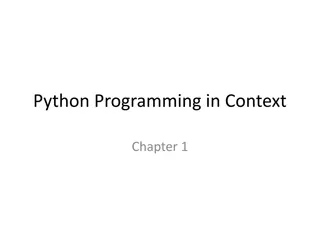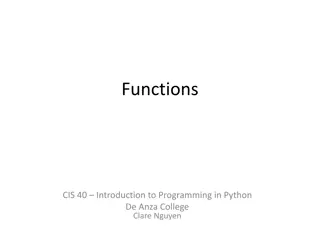Python Functions Overview
Functions in Python play a crucial role in organizing code, improving reusability, and enhancing program readability. Learn about the advantages of using functions, different types of functions, defining functions, and importing modules. Discover how functions help in modular programming, code sharing, and procedural abstraction. Explore the flexibility and efficiency functions offer in Python programming.
Download Presentation

Please find below an Image/Link to download the presentation.
The content on the website is provided AS IS for your information and personal use only. It may not be sold, licensed, or shared on other websites without obtaining consent from the author.If you encounter any issues during the download, it is possible that the publisher has removed the file from their server.
You are allowed to download the files provided on this website for personal or commercial use, subject to the condition that they are used lawfully. All files are the property of their respective owners.
The content on the website is provided AS IS for your information and personal use only. It may not be sold, licensed, or shared on other websites without obtaining consent from the author.
E N D
Presentation Transcript
CHAPTER -1 PYTHON FUNCTION
FUNCTION INTRODUCTION A FUNCTION IS A PROGRAMMING BLOCK OF CODES WHICH IS USED TO PERFORM A SINGLE, RELATED TASK. IT ONLY RUNS WHEN IT IS CALLED. WE CAN PASS DATA, KNOWN AS PARAMETERS, INTO A FUNCTION. A FUNCTION CAN RETURN DATA AS A RESULT. WE HAVE ALREADY USED SOME PYTHON BUILT IN FUNCTIONS LIKE PRINT(),ETC.BUT WE CAN ALSO CREATE OUR OWN FUNCTIONS. THESE FUNCTIONS ARE CALLED USER-DEFINED FUNCTIONS.
ADVANTAGES OF USING FUNCTIONS : 1.Program development made easy and fast : Work can be divided among project members thus implementation can be completed fast. 2.Program testing becomes easy : Easy to locate and isolate a faulty function for further investigation 3.Code sharing becomes possible : A function may be used later by many other programs this means that a python programmer can use function written by others, instead of starting over from scratch. 4.Code re-usability increases : A function can be used to keep away from rewriting the same block of codes which we are going use two or more locations in a program. This is especially useful if the code involved is long or complicated. 5.Increases program readability : It makes possible top down modular programming. In this style of programming, the high level logic of the overall problem is solved first while the details of each lower level functions is addressed later. The length of the source program can be reduced by using functions at appropriate places. 6.Function facilitates procedural abstraction : Once a function is written, it serves as a black box. All that a programmer would have to know to invoke a function would be to know its name, and the parameters that it expects 7.Functions facilitate the factoring of code : A function can be called in other function and so on
FUNCTION DEFINITION A function is a named sequence of statement(s) that performs a computation. It contains line of code(s) that are executed sequentially from top to bottom by Python interpreter. They are the most important building blocks for any software in Python.
TYPES Functions can be categorized as - i. Modules ii. Built in iii. User Defined
MODULE A module is a file containing Python definitions (i.e. functions) and statements. Standard library of Python is extended as module(s) to a programmer. Definitions from the module can be used within the code of a program. To use these modules in the program, a programmer needs to import the module.
HOW TO IMPORT MODULE? There are many ways to import a module in your program, the one's which you should know are: Import From
Import It is simplest and most common way to use modules in our code. Its syntax is: import modulename1 [,modulename2, ---------] Example >>> import math To use/ access/invoke a function, you will specify the module name and name of the function- separated by dot (.). This format is also known as dot notation. Example >>> value= math.sqrt (25) # dot notation
From Statement It is used to get a specific function in the code instead of the complete module file. If we know beforehand which function(s), we will be needing, then we may use from. For modules having large no. of functions, it is recommended to use from instead of import. Its syntax is: >>> from modulename import functionname [, functionname ..] >>>from modulename import * ( Import everything from the file) Example >>> from math import sqrt value = sqrt (25)
HOW TO CREATE PYTHON MODULE ? Python modules are .py files that consist of Python code. Any Python file can be referenced as a module. Some modules are available through the Python Standard Library and are therefore installed with your Python installation. Others can be installed with Python s package manager pip. Additionally, you can create your own Python modules since modules are comprised of Python .py files.
Writing a module is just like writing any other Python file. Modules can contain definitions of functions, classes, and variables that can then be utilized in other Python programs. To begin, we ll create a function that prints Hello, World!: hello.py # Define a function def world( ): print("Hello, World!") If we run the program on the command line with python hello.py nothing will happen since we have not told the program to do anything.
Lets create a second file in the same directory called main_program.py so that we can import the module we just created, and then call the function. This file needs to be in the same directory so that Python knows where to find the module since it s not a built-in module. main_program.py # Import hello module import hello # Call function hello.world() # or from hello import world
ACCESSING MODULES FROM ANOTHER DIRECTORY MODULES MAY BE USEFUL FOR MORE THAN ONE PROGRAMMING PROJECT, AND IN THAT CASE IT MAKES LESS SENSE TO KEEP A MODULE IN A PARTICULAR DIRECTORY THAT S TIED TO A SPECIFIC PROJECT.
APPENDING PATHS To append the path of a module to another programming file, you ll start by importing the sys module alongside any other modules you wish to use in your main program file. The sys module is part of the Python Standard Library and provides system-specific parameters and functions that you can use in your program to set the path of the module you wish to implement. For example, let s say we moved the hello.py file and it is now on the path /usr/sammy/ while the main_program.py file is in another directory. In our main_program.py file, we can still import the hello module by importing the sys module and then appending /usr/sammy/ to the path that Python checks for files.
main_program.py import sys sys.path.append('/user/sammy/') import hello ... As long as you correctly set the path for the hello.py file, you ll be able to run the main_program.py file without any errors and receive the same output as above when hello.py was in the same directory.
Built in Function Built in functions are the function(s) that are built into Python and can be accessed by a programmer. These are always available and for using them, we don t have to import any module (file).
USER DEFINED FUNCTIONS To define a function keyword def is used After the keyword comes an identifier i.e. name of the function, followed by parenthesized list of parameters and the colon which ends up the line. Next follows the block of statement(s) that are the part of function.
EXAMPLE def sayHello ( ): # Header print Hello World! Example Example- - def def area (radius): area (radius): a = 3.14*radius**2 a = 3.14*radius**2 return a return a Function call Function call >>> >>> print print area area ( (5 5) )
SCOPE OF VARIABLES SCOPE OF VARIABLES The part of the program where a variable can be used is known as Scope of variable Two types of scopes : Global Scope Local Scope
GLOBAL SCOPE GLOBAL SCOPE With global scope, variable can be used anywhere in the program eg: x=50 def test ( ): print( inside test x is , x) print( value of x is , x) Output: inside test x is 50 value of x is 50
LOCAL SCOPE LOCAL SCOPE With local scope, variable can be used only within the function / block that it is created . Eg: X=50 def test ( ): y = 20 print( value of x is , X, y is , y) print( value of x is , X, y is , y) On executing the code we will get Value of x is 50 y is 20 The next print statement will produce an error, because the variable y is not accessible outside the def()
MORE ON SCOPE OF MORE ON SCOPE OF VARIABLES VARIABLES To access global variable inside the function prefix keyword global with the variable Eg: x=50 def test ( ): global x =5 y =2 print( value of x & y inside the function are , x , y) Print( value of x outside function is , ) This code will produce following output: Value of x & y inside the function are 5 2 Value of x outside the function is 5
DEFAULT ARGUMENT DEFAULT ARGUMENT A default argument is a function parameter that has a default value provided to it. If the user does not supply a value for this parameter, the default value will be used. If the user does supply a value for the default parameter, the user-supplied value is used. Eg. def greet (message, times=1): print message * times >>> greet ( Welcome ) # function call with one argument value >>> greet ( Hello , 2) # function call with both the argument values. Output: Welcome HelloHello
QUESTION BASED ON FUNCTIONS What is the difference between methods, functions & user defined functions. Open help for math module i. How many functions are there in the module? ii. Describe how square root of a value may be calculated without using a math module iii. What are the two data constants available in math module.
Create a python module to find the sum and product of digits (separately) and imports in another program. Create a python function to find the a year is leap year of not a leap year What is local and global variable? Is global is keyword in python? Create a python module to find pow(x,n) and import in another program Write a function roll_D ( ), that takes 2 parameters- the no. of sides (with default value 6) of a dice, and the number of dice to roll-and generate random roll values for each dice rolled. Print out each roll and then return one string That s all . Example roll_D (6, 3) 4 1 6























